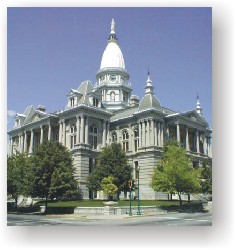 |
State and Local GovernmentPolitical Science 18-2101 |
 |
State and Local GovernmentPolitical Science 18-2101 |
|
Syllabus
This course examines the 50 states and a sample of the more than 80,000 local governments found in the United States. By focusing on an overview of the structures and functions of these governments, the course seeks to make the apparent endless complexity and variety of state and local governments more intelligible. Conceptualizing state and local politics as a political system this class analyze several components of state and local government. First, we study the environment: constitutions, federalism, and the political culture of each state. These elements make up the formal and informal rules that determine how public officials must operate. Second, we investigate interest groups, political parties, and public opinion. These are the informal actors who participate in the system by contacting officials on issues, voicing demand, lobbying, and participating in election campaigns. Third, we examine the political institutions: executive, legislative and judicial branches at both the state and local levels. These are the decision makers responsible for determining public policy. Fourth, we analyze public policies. Special attention will be given to the most current problems facing state and local governments, such as welfare reform, “going it alone financing,” and the impact of the post 9/11 world on state and local government. We also consider the need for reform of state and local government. Assigned Reading: Thomas R. Dye and Susan A. MacManus, Politics in States and Communities,
14th ed., Prentice Hall, 2012. Exams: There are four exams in this class. Each one follows completion of a major section of the reading assignments. All tests are multiple choice. A week after the original test a re-tests is given. The exam schedule lists the test dates. Keep in mind that these tests dates are tentative and may have to be changed for a variety of reasons. Grades: Grades are based on test scores. The tests are all objective (multiple-choice) questions. There are approximately 55 questions on each test. Each of the four tests will count equally. The final grade will be an average of all four tests. If you do not do well on the exams, there are two options: retake exams, and extra credit. Retests: The retest is a different set of questions from the original test but it covers the same material. Taking the retest is optional. There is no penalty for taking the retest since the highest score (either the original or retest) is the grade of record for each test. Extra Credit: Students who are not satisfied with their test scores can do extra credit. See extra credit for details of the projects. Extra credit can be done at any time during the semester. You can start it now or wait until the last week of class. Extra credit will be accepted until the date of the final exam, which is Wednesday May 9th. Test dates are listed in the exam schedule section of this Web page. Class Attendance Policy: Class attendance is mandatory. An attendance sheet is passed around the class at every session. Attendance is required for the following reasons. First, class lectures are not a repeat of assigned readings. Second, there are many times, as students who know me can tell you, where my interpretation differs from that presented in the text. I expect students to know the differences between what I say and what is presented in the readings. Third, tests are made up of questions that are about 50% from the readings and 50% from the notes If you do not come to class, the result may be a great deal of confusion at exam time. An additional incentive for coming to class is that a perfect attendance record will result in three points added to your final average. Office Hours: Office Location: Room 206 McNamara Hall
Use of the Internet with this Course
|
||||||||||||||||||||||||||
|
|
||
| Questions: Joe
Gaziano
Lewis University, One University Parkway, Romeoville, Il.,60446 |
||
 |
||||